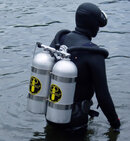Maybe I should have understood the differing drivers behind the switch to rebreathers.
1. Deep divers, requiring trimix, extended deco, etc
2. Shallow cave divers, long duration dives with a varied profile
3. Shallow open water divers, e.g. photographers looking to extend bottom time, avoid scaring the locals, reduce or eliminate deco obligation
4. Tech diving aficionado's. e.g. the groups of divers who want to understand and dive this technology because it exists not because they any specific requirement.
And I am sure there are others.
Each group may have differing requirements from the equipment.
With OC they have adapted their diving styles to compensate for the limitations of the equipment available.
I would fall into 3 however I still believe the technology is too imature to allow me to concentrate on photograpy and essentially ignoring the rebreather for minutes at a time but I could be wrong.
---------- Post added October 2nd, 2014 at 10:11 AM ----------
I think this will be the option with a bailout bottle that I will be looking at in the short term. Back to the gear that I trained on originally. However the techy in me still hankers after a rebreather.
View attachment 194246Take a Vintage style reg like this one, add a fine sponge to the rear mounted exhaust, and you have open circuit essentially as quiet/silent as a CCR, and all the bottom time any recreational diver will ever need--for a tiny fraction of the cost of any rebreather, and with a tiny fraction of the malfunction danger.
 Take a Vintage style reg like this one, add a fine sponge to the rear mounted exhaust, and you have open circuit essentially as quiet/silent as a CCR, and all the bottom time any recreational diver will ever need--for a tiny fraction of the cost of any rebreather, and with a tiny fraction of the malfunction danger.
Take a Vintage style reg like this one, add a fine sponge to the rear mounted exhaust, and you have open circuit essentially as quiet/silent as a CCR, and all the bottom time any recreational diver will ever need--for a tiny fraction of the cost of any rebreather, and with a tiny fraction of the malfunction danger.




